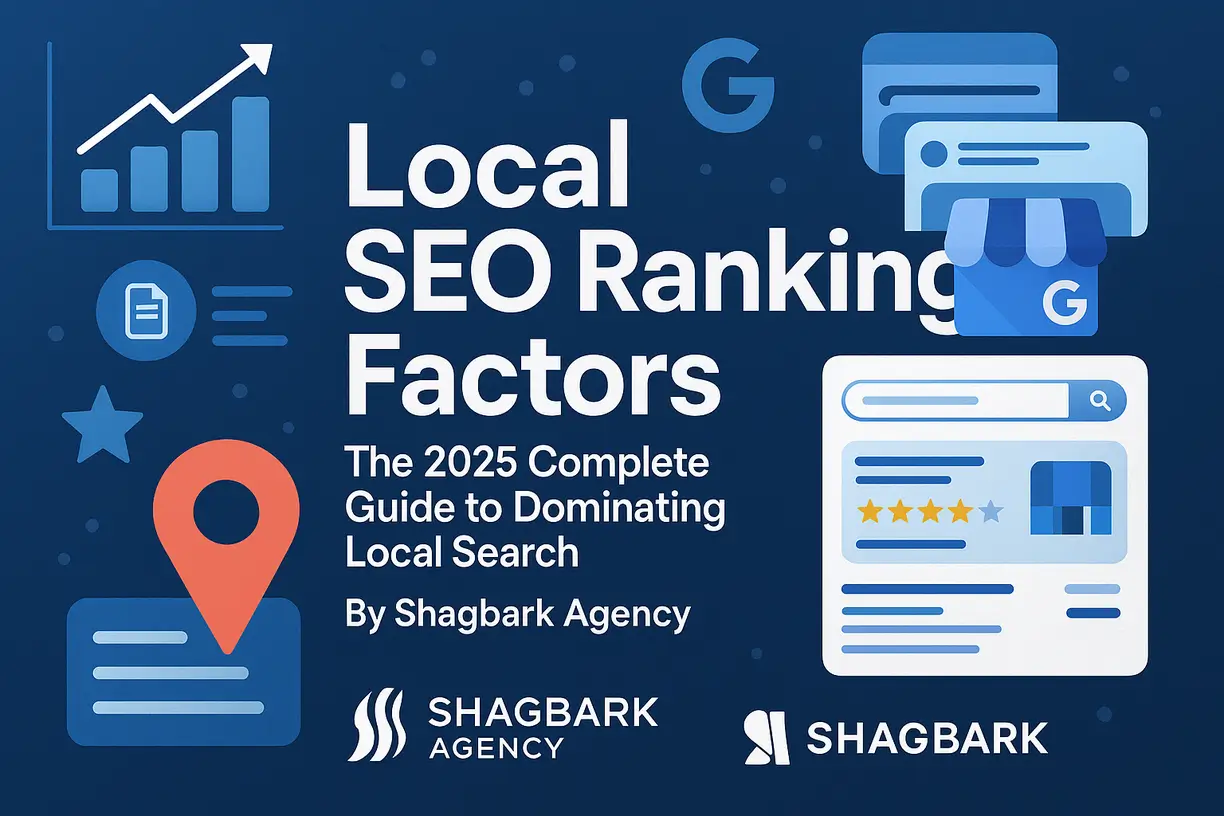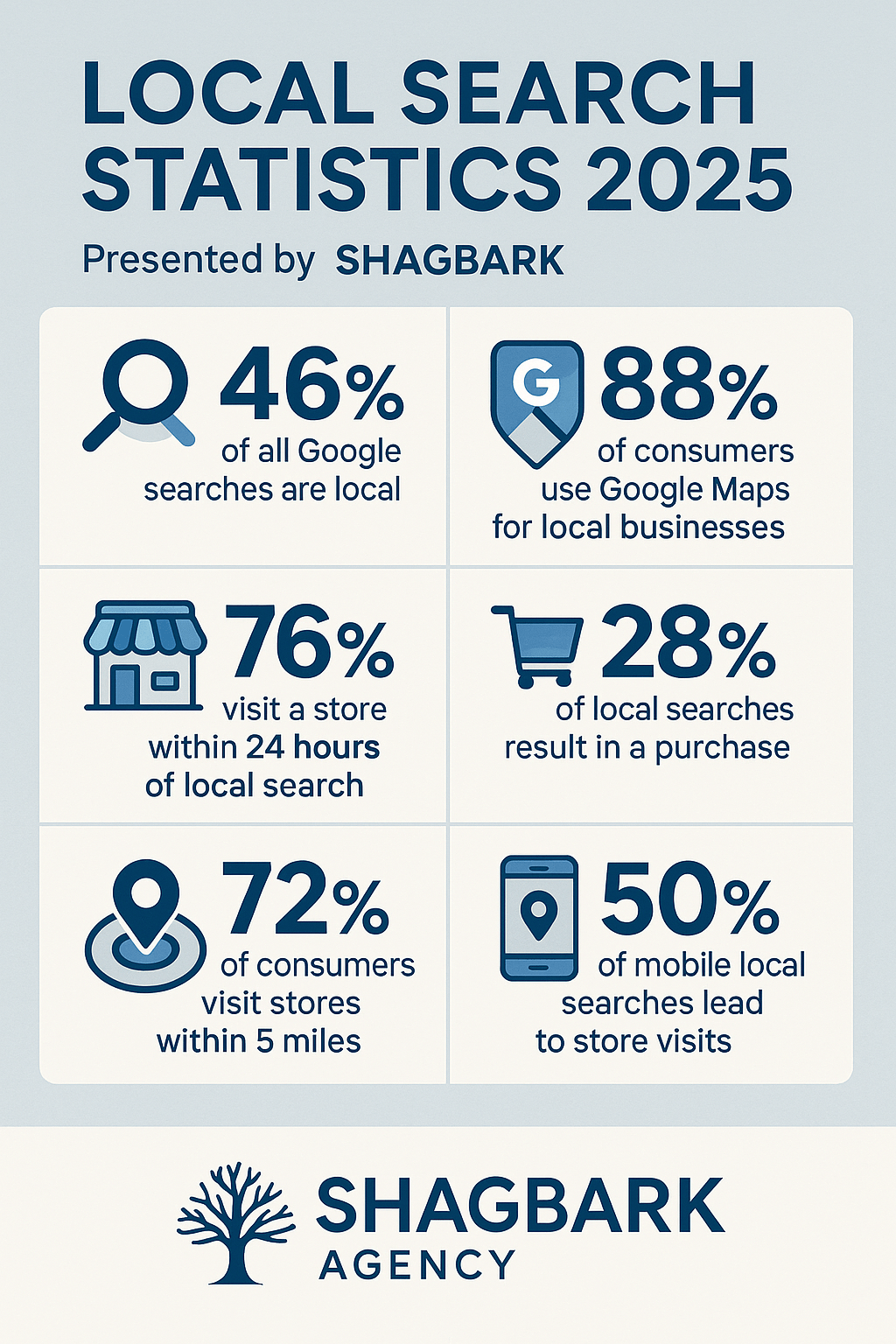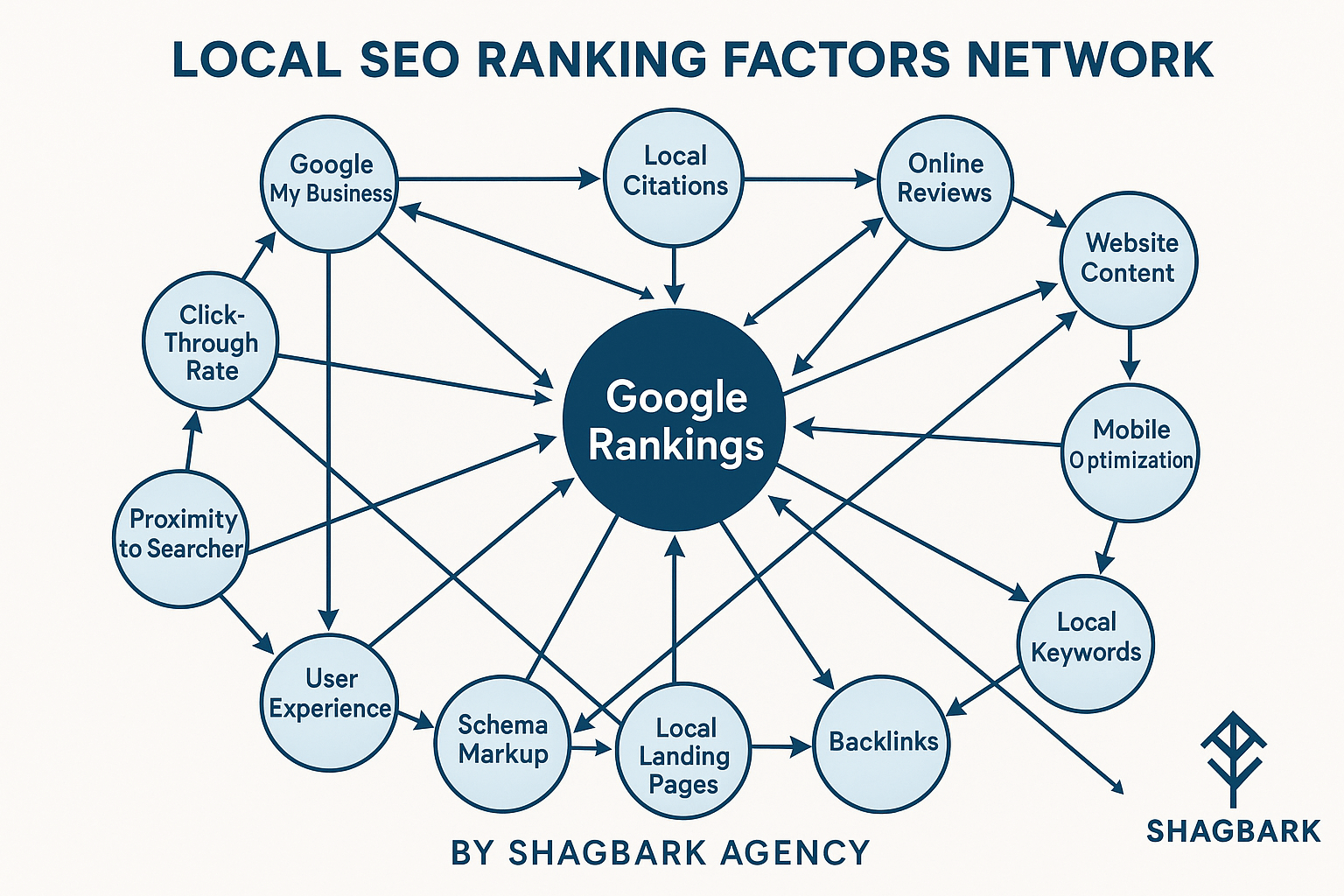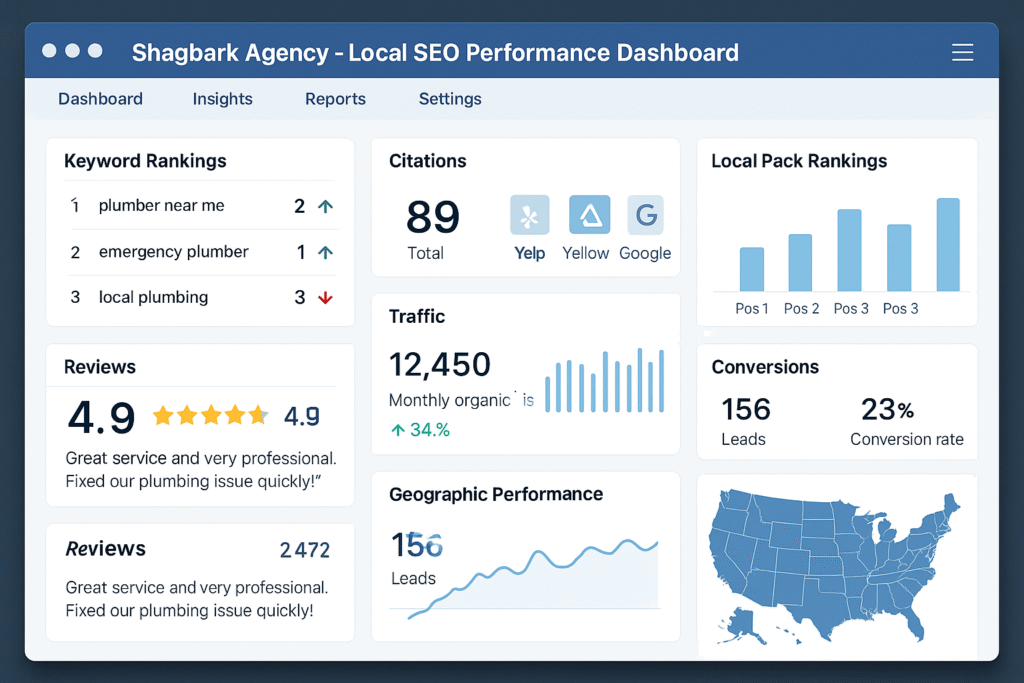
Understanding local SEO ranking factors has become critical for businesses competing in today’s digital marketplace. With 46% of Google searches having a local focus and “near me” searches growing by over 900% in recent years, mastering these ranking signals can make the difference between thriving and barely surviving online.
The landscape of local search has evolved dramatically. Google may use up to 149 ranking factors for local searches, making it more complex than ever to achieve consistent visibility. Yet businesses that understand and optimize for the essential local SEO ranking factors are seeing remarkable results.
This comprehensive guide reveals the most important ranking factors based on the latest industry research, Google’s official statements, and real-world performance data. Whether you’re a local business owner, agency founder, or marketing manager, you’ll discover exactly what drives local search success in 2025.

Key Takeaways
- Google’s three core local ranking factors—relevance, distance, and prominence—form the foundation for all local SEO optimization efforts
- Review recency has become critical in 2025—consistent new reviews matter more than total review count for maintaining and improving rankings
- Mobile optimization is non-negotiable—with 30% of mobile searches being location-related, mobile experience directly impacts local visibility
- Emerging factors like AI Overviews and menu optimization provide early-adopter advantages for businesses willing to stay ahead of trends
- Integrated optimization across multiple factors produces better results than focusing on individual ranking signals in isolation
Google’s Core Local Ranking Factors: The Foundation (Relevance, Distance, Prominence)
Google’s local search algorithm operates on three fundamental principles: relevance, distance, and prominence. These core google ranking factors for local seo form the foundation upon which all other optimization efforts build.
Understanding Relevance in Local Search
Relevance measures how well your business matches what someone is searching for. To help Google better understand your business and match it to relevant searches, you must provide complete and detailed business information.
This goes beyond basic contact details. Your business category selection, service descriptions, and content must align perfectly with user search intent. If the business category is incorrect, it may not rank at all for the desired product and service keywords.
Distance: The Geography Advantage
Distance refers to how far each business is from the customer who’s searching. This ranking factor gives local businesses their competitive edge against larger, national competitors.
The distance from the searcher to the business is the ultimate unique selling proposition of local search engine rankings. However, distance alone won’t guarantee rankings—it must work in harmony with relevance and prominence.
Prominence: Building Authority That Counts
Prominence means how well-known a business is, based on information like how many websites link to your business and how many reviews you have. This factor encompasses your overall online reputation and authority signals.
Modern prominence extends beyond traditional metrics. Google’s popular time graph could signal that a business is “hot,” potentially resulting in a boost for business rankings. Your digital footprint, review profile, and local community engagement all contribute to prominence.
Section Highlight: The three core factors work synergistically—optimizing for just one while neglecting others will limit your local search potential. Focus on achieving strong performance across all three pillars.
The 15 Essential Local SEO Ranking Factors for 2025
The most successful local businesses understand that ranking factors work together as a comprehensive system. Here are the essential local seo ranking factors that matter most based on current industry research and Google’s algorithm updates.
Google Business Profile Optimization (Factor #1)
32% of SEO professionals believe that Google Business Profile is the most essential factor to rank well in the map pack. Your GBP serves as your digital storefront and primary information source for Google’s algorithm.
Complete optimization requires more than basic information. 75% of marketers think that the use of Google Business Profile features affects local rankings. This includes regular posts, Q&A management, photo uploads, and service/product listings.
Critical GBP optimization elements include accurate business categories, comprehensive business descriptions, high-quality photos, and consistent posting of updates. Verified businesses receive over 21,643 views each year in Google searches, making verification a non-negotiable first step.
Review Signals: Quality, Quantity & Recency (Factors #2-4)
The most prominent local SEO ranking factor is review signals. However, the review landscape has become more sophisticated than simple star ratings.
Review Quantity: More reviews generally correlate with higher rankings, but there’s a quality threshold. A local SEO or local business should always strive to keep their rating above 4 stars on Google.
Review Quality: Reviews with a lot of text where customers talk about the services they received and their experiences carry more weight. Detailed reviews that mention specific services, employee names, and outcomes provide stronger ranking signals.
Review Recency: Review recency is one of the most important ranking factors of 2025. Businesses must maintain a consistent flow of new reviews to maintain and improve rankings. The moment you stop getting new reviews, you’re going to see your local rankings start to slip.
On-Page SEO and Local Content (Factor #5)
36% of SEO professionals consider on-page elements to be the top ranking factor for local organic search results. Your website must reinforce the local relevance signals established in your GBP.
Essential on-page elements include location-specific title tags, locally-optimized content, proper NAP (Name, Address, Phone) placement, and schema markup. The presence of vital details such as name, address and phone number (NAP) on pages assists in on-page ranking factors.
Content strategy should focus on local topics, community involvement, and service area coverage. Create location-specific service pages, local resource guides, and community-focused content that demonstrates your local expertise and connection.
Citation Consistency and NAP Data (Factor #6)
Local citations make up 8% of ranking factors. Citations are mentions of your business name, address, and phone number across the web, and consistency is crucial for ranking success.
Your web pages must have the correct and up-to-date business information across all directories because citations help Google confirm that your business is legit and trustworthy. Inconsistent NAP data confuses search engines and can harm rankings.
Focus on major citation sources first: Google Business Profile, Bing Places, Apple Maps, and industry-specific directories. Then expand to local chambers of commerce, news sites, and community organization websites.
Local Link Building and Authority (Factor #7)
Using high-quality links from trusted sources or trusted websites improves your chances of ranking. Local link building requires a different approach than traditional SEO link building.
Effective local link strategies include partnerships with local businesses, sponsorships of community events, guest posting on local news sites, and building relationships with local organizations. These links signal geographic relevance and community authority.
Quality matters more than quantity. If your backlinks are from spammy or untrustworthy sources, that can hurt your chances of getting on Google’s top page. Focus on earning links from locally relevant, high-authority sources.
Behavioral Signals and User Engagement (Factor #8)
Behavioral signals make up 11% of ranking factors in SEO and are based on a theory that the more people that click on your website or directory listings in any search result, the more times it will show up.
Google monitors how users interact with your business listings. High click-through rates, longer time spent on your website, and positive user behaviors signal that your business provides value to searchers.
If visitors stay, scroll, and click around your page, Google takes that as a thumbs-up and rewards you with better rankings. This makes user experience optimization crucial for local SEO success.
Mobile Experience and Page Speed (Factor #9)
30% of all Google mobile searches relate to location, making mobile optimization essential for local search success. 63% of people prefer using their mobile phones to look up info about brands and products.
Your website must load quickly and provide an excellent mobile experience. Google’s mobile-first indexing means your mobile site version is the primary version Google uses for ranking and indexing.
Key mobile optimization factors include fast loading times, easy navigation, click-to-call functionality, and simplified contact forms. Mobile users often have immediate needs, so removing friction is critical.
Business Hours and Availability (Factor #10)
Business hours are a significant local SEO ranking factor on Google. If a business is listed as closed, it isn’t relevant to the searcher. Accurate, up-to-date hours information directly impacts your visibility.
53% of consumers see accurate opening hours as the most important detail for retail stores. Incorrect hours not only hurt rankings but damage customer trust and can lead to negative reviews.
Update holiday hours promptly, maintain consistency across all platforms, and consider the impact of service availability on your ranking potential during different times.
Pro Tip: The most successful local businesses treat ranking factors as interconnected systems rather than isolated tactics. Optimize holistically for maximum impact.

Emerging Local SEO Ranking Factors in 2025
The local search landscape continues evolving rapidly. New ranking factors are emerging that forward-thinking businesses can leverage for competitive advantage.
AI Overviews and Featured Snippets
In some cases, Google may show an AI-generated summary for local searches before the map pack — especially for queries like “best [service] near me”. These AI Overviews represent a significant shift in how local search results appear.
To optimize for AI Overviews, focus on creating comprehensive, well-structured content that directly answers common local search questions. Use clear headings, bullet points, and FAQ sections that make your content easy for AI to understand and reference.
Menu Items and Service Descriptions
Menu Items and Menu Highlights on a restaurant’s Google Business Profile influence rankings. This factor has expanded beyond restaurants to include detailed service descriptions for all business types.
Match menu item names to exact search queries to maximize this ranking opportunity. Service-based businesses should list specific services that match how customers search, using natural language rather than industry jargon.
Popular Times and Peak Traffic Signals
Higher traffic during peak times is becoming a crucial factor in local rankings. Google’s Popular Times data helps identify when businesses are busiest, and this information now influences ranking algorithms.
Updating local rank reports during busier times should be a key part of your SEO strategy moving forward. Businesses should optimize their visibility efforts around their peak traffic periods.
Section Highlight: Early adoption of emerging ranking factors provides competitive advantages. Monitor Google’s feature rollouts and test optimization strategies for new ranking signals.
How Local SEO Ranking Factors Work Together: The Multiplier Effect
Understanding individual ranking factors is important, but recognizing how they amplify each other is crucial for local SEO success. The most effective local SEO strategies create synergies between multiple factors.
For example, consistent citations support your GBP optimization, which enhances your review generation efforts, which improves your prominence signals. Each factor reinforces the others, creating a multiplier effect that compounds your ranking improvements.
The Google local algorithm is constantly updating to ensure that search results best match the intent behind a user’s query. This means isolated optimization efforts become less effective over time, while comprehensive, integrated strategies maintain and improve rankings.
The businesses that dominate local search understand this interconnection. They don’t just optimize their GBP or build citations—they create cohesive local presence strategies that address multiple ranking factors simultaneously.
Pro Tip: Audit your current local SEO efforts to identify gaps where ranking factors aren’t working together. The biggest opportunities often exist at the intersections between different optimization tactics.
Local SEO Ranking Factors by Business Type: Tailored Strategies
Different business models require different approaches to local SEO ranking factor optimization. Understanding these distinctions helps prioritize efforts and resources effectively.
Service Area Businesses
Service area businesses face unique challenges because they serve customers at various locations rather than having customers visit a physical storefront. Distance becomes more complex, and relevance must be established across multiple service areas.
Focus on creating location-specific landing pages for each service area, building citations in multiple localities, and earning reviews that mention specific service locations. Your GBP should clearly define your service areas while maintaining accuracy.
Multi-Location Brands
Multi-location businesses must scale local SEO ranking factor optimization across multiple profiles while maintaining consistency and avoiding duplicate content issues.
Implement standardized optimization processes while allowing for local customization. Each location needs its own complete optimization strategy, but brand consistency across all factors remains crucial for overall authority building.
Single-Location Retailers
Single-location retailers can focus intensively on dominating their immediate geographic area. This concentrated approach allows for deeper optimization of all ranking factors within a specific market.
Prioritize hyper-local content creation, community involvement, and building strong relationships with other local businesses. Your concentrated geographic focus should translate into market-leading optimization depth.
Section Highlight: Tailor your ranking factor prioritization to your business model. Service area businesses should emphasize content and citations, while retailers should focus on location-specific authority building.
Measuring Your Local SEO Performance: KPIs That Matter
52% of marketers consider local pack rankings a key factor in SEO success. However, rankings are just one metric in a comprehensive local SEO measurement strategy.
Key performance indicators should include local pack rankings, Google Business Profile insights (views, calls, direction requests), organic local keyword rankings, and conversion metrics like phone calls and form submissions. Businesses receive around 595 calls a year, or about 50 calls a month, from their verified Google Business Profiles.
Track competitor performance alongside your own metrics. How often are your top competitors getting new reviews? If the answer is twice a month, you should also aim for that, plus 1. Competitive intelligence helps establish realistic benchmarks and identify opportunities.
Use specialized local SEO tools that provide accurate ranking data from multiple locations. Looking at Google search results doesn’t give you the most accurate representation of where your business ranks locally, making professional tracking tools essential.
Pro Tip: Set up automated reporting that tracks your progress across all major ranking factors monthly. Consistent measurement enables proactive optimization adjustments before ranking drops occur.

Conclusion: Mastering Local SEO Ranking Factors for Long-Term Success
Success in local search requires understanding that local SEO ranking factors work as an interconnected system rather than isolated tactics. The businesses dominating local search in 2025 are those that optimize comprehensively across all ranking factors while staying ahead of emerging trends.
The local seo important ranking factors we’ve covered from Google Business Profile optimization to emerging AI Overview signals, provide the foundation for sustained local search success. However, implementation and ongoing optimization separate successful businesses from those that struggle with visibility.
Ranking in local search is becoming more difficult every day due to increased competition. The businesses that thrive are those that treat local SEO as an ongoing strategic priority rather than a one-time optimization project.
Your local search success depends on consistent, expert-level optimization across all essential ranking factors. Don’t let technical complexity or resource constraints prevent you from capturing the qualified leads searching for your services right now.
Ready to dominate local search in your market? Book your free video SEO audit to discover exactly which ranking factors need immediate attention and receive a customized roadmap for local search success. Our detailed analysis will identify your biggest opportunities and provide actionable next steps to improve your visibility, attract more qualified leads, and grow your business through local search.
Check Our Other Important Guides:
Google Business Profile Category Optimization Guide
How to Recover Local SEO Rankings
Google Business Profile Posts Best Practices
Frequently Asked Questions
Q: What are the most important local SEO ranking factors in 2025?
A: The most important factors are Google Business Profile optimization, review signals (quality, quantity, and recency), on-page SEO with local content, citation consistency, and mobile user experience. These core factors account for the majority of local ranking influence.
Q: How many Google ranking factors affect local SEO?
A: Google may use up to 149 different ranking factors for local searches, but the essential local SEO ranking factors number around 15-20. Focus on mastering the core factors before addressing secondary ranking signals.
Q: How often should I get new Google reviews for optimal local SEO?
A: Review recency is crucial in 2025. Aim to receive new reviews at least as frequently as your top competitors, ideally 2-4 reviews per month for most local businesses. Consistency matters more than volume bursts.
Q: Do local citations still matter for local SEO ranking factors?
A: Yes, local citations account for approximately 8% of ranking factors and remain important for establishing business legitimacy and consistency. Focus on accuracy and consistency across major directories and industry-specific citation sources.
Q: What’s the difference between local pack and local organic ranking factors?
A: Local pack rankings (the map results) prioritize proximity, Google Business Profile optimization, and review signals. Local organic rankings blend traditional SEO factors with local relevance signals, emphasizing content quality and local authority building.
Q: How do behavioral signals impact local SEO rankings?
A: Behavioral signals account for about 11% of ranking factors and include click-through rates, time on site, and user engagement with your business listings. Positive user behavior signals indicate business quality and relevance to Google’s algorithm.
Need Help with Local SEO Recovery?
If your local business has lost search rankings and needs expert recovery assistance, our team of Local SEO specialists is ready to help. Contact us for a free local SEO audit and recovery consultation.
Get Free Local SEO Audit
3 thoughts on “Local SEO Ranking Factors: The 2025 Complete Guide to Dominating Local Search”
Comments are closed.